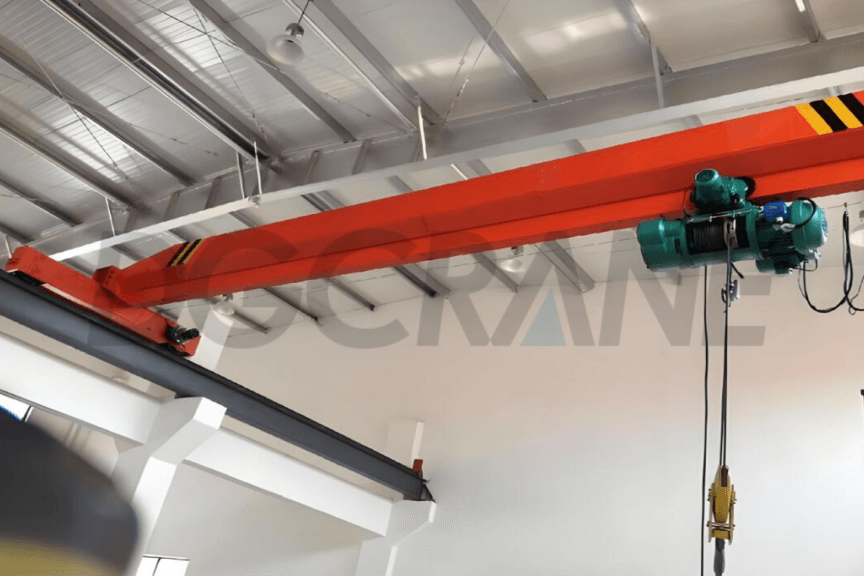Electric Hoist Troubleshooting: 6 Common Failures and Solutions
Table of Contents
As an essential lifting device in industrial production, the electric hoist plays a vital role in ensuring both productivity and safety. Its stable operation is crucial for maintaining workflow efficiency and preventing workplace accidents. However, during daily use, various issues may arise that affect performance or even endanger operators. This article summarises common electric hoist malfunctions and their corresponding solutions to help users quickly diagnose and resolve problems, ensuring safe and efficient operation.

1. Unusual Noise During Operation
Abnormal noises from an electric hoist often signal the beginning of mechanical failure. For example, problems in the motor or gearbox can cause unusual sounds. Regular attention to operational noises can help detect issues early.
Motor Noise
When noise originates from the motor, the hoist should be stopped immediately. Inspect for bearing damage, rotor scraping, single-phase operation, or misalignment. Much like human ailments, mechanical issues often show external symptoms.
- A “humming” sound usually indicates single-phase operation.
- A “clanking” sound often points to bearing damage.
- Misalignment or rotor scraping produces high-pitched, piercing noises that may vary in tone.
Gearbox Noise
Gearbox noise typically results from wear in one or more components:
- Gearbox housing
- Bearings
- Gears
Check whether the lubricant has been replaced regularly. If not, begin with an oil change. Inspect for gear damage or deformed bearings and replace components as needed.
2. Hoist Not Responding When Switch is Pressed
This is one of the most common issues, and there are three main causes:
- Power Supply Not Connected:
Always verify the power is connected—it's the most common oversight. - Switch Circuit Issue:
Overheating from prolonged use or mechanical impact may cause internal wiring damage or loose connections. Inspect for burned or dislodged wires. - Low Voltage Supply to Motor:
If the voltage supplied to the motor is more than 10% below the rated voltage, the hoist will not lift loads. Use a voltmeter to measure and ensure the voltage is within the acceptable range before restarting.
3. Hoist Fails to Stop After Operation
If the hoist continues to move even after pressing the stop button—rising or lowering to the limit—it's typically due to contact welding of the contactor. The stop contact fails to open, and the motor keeps running. In such cases, immediately shut off the main power and inspect or replace the contactor.
4. Hoist Slips After Stopping
Over time, electric hoists may exhibit slippage due to brake system issues:
- Worn brakes
- Loose nuts
- Weakened springs
Adjust the brake nut as specified in the hoist manual. Replace worn brake pads or springs if needed.
Dust and oil contamination can also impair braking, especially oil, which causes excessive slippage. In some cases, if the motor coupling is stuck or moves improperly, the brake disc may not contact properly with the end cap, leading to inconsistent braking. Inspect and repair or replace the coupling accordingly.
5. Gearbox Oil Leakage
Oil leaks from the gearbox are usually due to:
- Worn or damaged sealing rings between the housing and cover – Replace the seal.
- Loose bolts on the gearbox – Tighten the bolts once the hoist is stopped.
6. Motor Malfunction
Long-term continuous operation may cause motor overheating due to overloading or poor lubrication. Other issues include faulty contactors, fuse failures, or wiring errors.
Common Motor Failures and Solutions:
Overheating:
- Often caused by overloading. Stay within the hoist's rated capacity.
- Worn or damaged bearings can also lead to overheating.
- If the brake clearance is too small, friction will increase, leading to excess heat and motor strain. Stop the hoist and adjust the brake gap.
Blown fuses or tripped breakers:
- Check the current rating, replace fuses, or reset breakers as needed.
Incorrect phase wiring or phase loss:
- Reverse the two phases to correct.
Broken or poorly connected power/control wires:
- Repair or replace faulty wiring.
Burned control circuit fuse:
- Replace with the correct fuse type.
Low power supply voltage:
- Use a voltmeter to check if voltage is more than 10% below rated.
Motor humming but not rotating:
- Check motor phase sequence and insulation, then repair.
Contactor malfunction:
- If manual operation works, inspect control wiring for poor contact.
- If both manual and electrical operation fail, check the main power. If power is present, the contactor is likely faulty and must be replaced.
Emergency stop activated:
- Investigate and release the emergency stop button.
Contactor coil failure:
- Replace the coil or the entire contactor.
Rotor-Stator Rubbing (“Rotor Scraping”):
- Usually caused by excessive wear on the support ring or rotor misalignment. Stop the hoist, replace the support ring, and readjust the stator-rotor clearance or send the motor for professional repair.
Conclusion
The safe and efficient operation of electric hoists depends on correct use and regular maintenance. By identifying and addressing problems promptly, users can extend equipment lifespan, maintain smooth production, and ensure workplace safety. For complex or unresolvable issues, it is highly recommended to consult professional technicians for inspection and repair. A well-maintained electric hoist not only safeguards operations but also plays a key role in boosting overall productivity.
Contact Details
DGCRANE is committed to providing the professional Overhead crane products and relavent service. Exported to Over 100 Countries, 5000+ Customers Choose Us, Worth to be Trusted.
Get In Touch
Fill out your details and someone from our sales team will get back to you within 24 hours!



































































































































